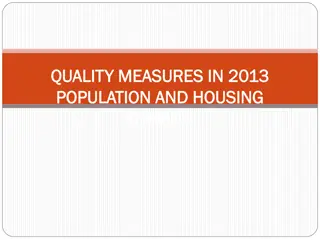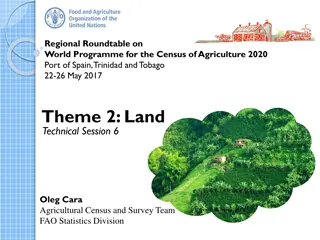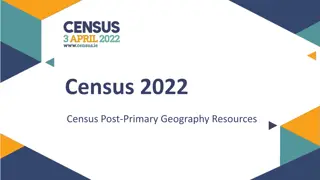Importance of Forestry in Agricultural Census - Regional Roundtable World Programme
Forestry is crucial for providing food, materials, medicines, employment, and income to a third of the world's population. It plays a significant role in agro-forestry, soil conservation, and environmental preservation. The census items related to forestry include presence of woodland, area of woodland, purposes of woodland, and practice of agroforestry. It is essential to include all forestry holdings in agricultural censuses to capture a complete picture of forestry activities.
Download Presentation

Please find below an Image/Link to download the presentation.
The content on the website is provided AS IS for your information and personal use only. It may not be sold, licensed, or shared on other websites without obtaining consent from the author.If you encounter any issues during the download, it is possible that the publisher has removed the file from their server.
You are allowed to download the files provided on this website for personal or commercial use, subject to the condition that they are used lawfully. All files are the property of their respective owners.
The content on the website is provided AS IS for your information and personal use only. It may not be sold, licensed, or shared on other websites without obtaining consent from the author.
E N D
Presentation Transcript
Regional Roundtable World Programme for the Census of Agriculture 2020 Port of Spain, Trinidad and Tobago 22-26 May 2017 Theme 13 and 15: Forestry and Environment/greenhouse gas (GHG) emissions Technical Session 14 Adriana Neciu Agricultural Census and Survey Team FAO Statistics Division 1
Outline Background Importance of the theme Items Concepts and definitions 2
Background Theme 13: Forestry refers to forest and other wooded areas on the agricultural holding. In order to harmonize with the new concepts and classifications from the SEEA 2012*, some items from the WCA 2010 have changed as follow: The wording forest and other wooded land changed to: woodland . are not covered Units engaged in forestry unless they also had some crop or livestock production activities. In order to have a complete picture of forestry activities country, all forestry holdings should be included and not just those agriculture holding: Forestry census. in a associated with an *SEEA: System of Environmental-Economic accounting. United National Statistical Commission 2012 3
Importance of forestry One-third of the world s people depend on forest goods and services provision of food, materials, medicines, employment and cash income. for fuel, the direct building wood Forests are not only important for the people who live in them, but also for those living in adjacent landscapes.* Agro-forestry plays an important role in soil conservation, livestock environmental preservation. production and *XIV World Forestry Congress. Durban, South Africa, Sept. 2015 4
Items Theme 13: Forestry comprises 4 items (for the holding) 1301 Presence of woodland on the holding; (frame item) 1302Area of woodland; 1303 Purposes of the woodland; 1304Whether agroforestry is practiced (frame item) 5
Item 1301: Presence of woodland on the holding Type: Frame item. Reference period: Census reference day Concept: If some area of the holding is classified as forest and other wooded land in Land item 0202, then the holding contains wooded areas. However, this may not be sufficient for identifying all holdings with wooded areas potentially usable for forestry activities or other purposes because: Land use classification is based on the concept of main use of the land. For example, land under permanent meadows and pastures may span over 0.5 ha, with higher than 5m and crown cover of more than 10%. To identify all holdings with forest and other wooded land, data on secondary land use are needed. The criterion of spanning over 0.5 ha limits capacity of the land-use approach for identifying all holdings with wooded areas potentially usable for forestry. In some countries, small wooded areas on holdings may play an important role in sustaining livelihoods. Because of the above considerations, the concept of woodland is introduced here. It refers to the area of land satisfying all criteria for either forest land or other wooded land except the criterion of spanning over 0.5 ha. 6
Item 1302: Area of woodland (for the holding) Type: Additional item Reference period: Census reference day Concept: This item collects data on the total area of woodland on the holding as defined in item 1301 further subdivided into various components: land classified as forest land and other wooded land in the land use classification (Item 0202); a.Forest land as primary land use; b.Other wooded land as primary land use; those areas on the holding that satisfy the criteria for forest land and other wooded land, but were classified as agricultural land according to their primary land use. (Agricultural land covers arable land, land under permanent crops, and permanent meadows and pastures.) c. Forest land as secondary land use on agricultural land d.Other wooded land as secondary land use on agricultural land those areas that span less than 0.5 ha and satisfy all other criteria for either forest land or other wooded land. e.Other Woodland 7
Item 1303: Purposes of woodland (for the holding) Type:Additional item Reference period: Census reference year Concept: This item relates to all woodland on the holding, including all categories listed in Item 1302. Purposes: Production: Wood and non-wood Soil and water protection: - protection of soils from wind and water erosion. Improving agricultural production: - trees integrated into agricultural systems, providing a range of benefits in terms of restoring or sustaining soil fertility and boosting food production. Social and cultural values: when forest area is primarily designated or managed for spiritual or cultural values or practices. Recreation and ecotourism: Such as Agrotourism and ecotourism, which can conserve natural resources, provide employment opportunities and boost the rural economy Other: with not specific function 8
Item 1304: Whether agroforestry is practiced (for the holding) Type: Frame item Reference period: Census reference year Concept: Agroforestry is a sustainable land management system in which forest species of trees and other wooded plants are purposely grown on the same land as agricultural crops or livestock, either concurrently or in rotation. Agroforestry includes: agrosilvicultural (trees and crops) silvopastoral (trees and livestock), agrosilvipastoral (trees, crops and livestock) systems. Notes: Agroforestry refers to specific forestry practices that complement agricultural activities, such as by improving soil fertility, reducing soil erosion, improving watershed management, or providing shade and food for livestock. Countries need to develop their own procedures to collect data on agroforestry systems. Some may wish to collect data on specific agroforestry activities. 9
Country experiences Chile: VII Agriculture and Forestry Census 2007 Section IX of the census questionnaire is devoted to Forest Area . Cultivated forest - for each one of ten species of cultivated forest: aspen, mimosa, eucalyptus niplen eucalyptus globolus, pine radiatus, pine oregon, rauli, coig e, oak, tamarugo the following information was recorded: - planted area - forests age - whether forest management and/or irrigation were applied. Native forest in the case of native forest the information collected were recorded for 12 native spices: - area covered - whether forest management was used In case that trees were used as windbreakers, the total linear meters involved were also recorded. In Section XVI Other activities on holding, several forest produces were also investigated: carbon, firewood, wood for pulp; wood for sawmills and mushrooms. In the Section Land use, it was recorded the type of uses for forests: livestock, wood, unexplored forests and rest of forest and wodland. 10
Theme 15: Environment/greenhouse gas (GHG) emissions Contents Background Sources of GHG emissions GHG items on crop and livestock production subsectors Concepts and definitions Country experiences 11
Background Under the UN Framework Convention on (UNFCCC), countries should produce and regularly report their GHG emissions from all sectors, including achievement of their targets. Climate Change agriculture to monitor the In response to the growing demand for basic agro-environmental data on GHG and ammonia emissions, the theme (theme 15) with items covering relevant crop and livestock production subsectors. WCA 2020 introduced this new Theme 15 gives possibility for countries to establish the baseline for reports and provide a frame for periodic sample surveys. (Some of the items are already covered in other themes of the WCA 2020) 12
Sources of GHG emissions in agriculture Enteric Fermentation Crop Residues Manure Management Cultivation of Organic Soils Rice Cultivation Burning Savanna Synthetic Fertilizers Burning - Crop Residues Manure applied to Soils Energy Use in Agriculture Manure left on Pasture 13
GHG items on livestock production subsector Relevant existing items (explained in Theme 5): 0501: Type of livestock system 0504: Number of animals: age and sex (for each livestock type) 0505: Number of animals according to purpose (for each livestock type). New items (Theme 15): 1501 Type of animal grazing practices 1502 Manure application 1503 Manure management system 1504 Final use of the treated manure. 14
Item 1501: Type of animal grazing practices Type:Additional item Reference period: Census reference year Concept: Animal grazing has a significant impact on the quality of pastures. Combining the information from the livestock theme with types grazing improves estimation of the status of pastures non-degraded, moderately degraded degraded. Importantly, this item allows for more accurate estimation of the which manure is left on pasture. severely or area in 15
Item 1501: Type of animal grazing practices (cont d.) Types of animal grazing: Grazing on the holding: Area grazed during the year Number of animals Fraction of the year with animals on pasture Common pasture grazing: Number of animals Fraction of the year with animals on pasture (e.g. <3; 3-6; 6-9; 9> months). 16
Item 1502: Manure application Type: Additional item Reference period: Census reference year Note: This item is relevant for the indicators and particularly for GHG and applicable to holdings with a nomadic livestock system. calculation of agro-environmental ammonia emissions. Not Categories for manure application: Percentage of holding s pastures on which the manure is left on pasture Fraction of manure left on pasture that is removed for use as fuel (0; 50% or less; more than 50%; all manure removed) Agricultural area on which solid/farmyard manure is applied (spread) Agricultural area on which slurry is applied (spread) Manure directly daily spread on the field. 17
Item 1503: Manure management system Type: Additional item Reference period: Census reference year Note: This item is relevant for the calculation of agro-environmental indicators and particularly for GHG and ammonia emissions. Not applicable to holdings with a nomadic livestock system. 18
Item 1503: Manure management system (cont d.) Categories: Availability of storage facilities for: Solid/farmyard manure Liquid manure Slurry Type of storage facilities used: For all manure: Digesters(biogas reactors) For slurry: Slurry tank Anaerobic lagoon Aerobic treatment Covered or open storage facilities: Solid/farmyard manure Liquid manure Slurry 19
Item 1504: Final use of the treated manure Type: Additional item Reference period: Census reference year Concept: This item refers to percentage use of manure exiting the manure management system, and applicable to all holdings with a non- nomadic type of livestock system. Categories: Applied as fertilizers Used for fuel (manure used for production of energy, it does not include manure left on pasture, collected and dried for dung cakes already reported in item 1502) Used for construction (used as component of construction materials) Used as feed Other uses (e.g. manure delivered to others for fertilizer). 20
GHG items on crop production subsector Relevant existing items (explained in Themes 4 and 6): 0411: Use of each type of fertilizer 0412: Area fertilized for each type of fertilizer and major crop type 0610: Type of tillage practices. New items (Theme 15): Submodule on rice cultivation (Rice cultivation accounts for 10% of global GHG emissions in agriculture, but is significantly higher in rice-producing countries). 1505 Length of the growing period for rice cultivation 1506 Rice cultivation irrigation and water regimes 1507 Organic amendments to soils used for rice cultivation 1508 Crop residues 1509 Permanent crops age of plantations. 21
Item 1505: Length of the growing period of the rice cultivation Type: Additional item Reference period: Census reference year Concept: Length of the growing period means number of months between crop planting and harvest. 22
Item 1506: Rice cultivation irrigation and water regimes Type: Additional item Reference period: Census reference year Concept: This item complements the information collected in Theme 3: Irrigation, specifically for rice irrigation and water regimes. Water regimes before the growing period: Flooded pre-season: the land has been flooded for 30 consecutive days or more just prior to planting; Non-flooded pre-season: the land has been flooded for less than 30 consecutives days or has not been flooded prior to planting. Water regimes during the growing period: Irrigated continuously flooded: field with standing water throughout the rice growing period; Irrigated intermittently flooded: field that has at least one aeration period of more than three days during the growing period; Rice cultivation in rainfed and deep-water area: rice grown of flooded surface, in areas depending entirely on rain for water supply. 23
Item 1507: Organic amendments of soils used for rice cultivation Type: Additional item Reference period: Census reference year Concept: Additionally to information on fertilizers (Theme 4 Crops ), the following breakdown of organic fertilizers gives important information on rice cultivation practices: Straw incorporated shortly before cultivation (30 days or less) Straw incorporated long before cultivation (more than 30 days) Compost Farmyard manure Green manure 24
Item 1508: Crop residues Type: Additional item Reference period: Census reference year Concept: Management and use of crop residues may affect the environment. This item is applicable to all holdings. Handling of crop residues includes the following: Crop/pasture area burnt on the holding: refers to the area of crop/pasture where crop residues/grass are burned during the reference year. Crop residues removed from field: describes the fraction of crop residues (such as straw, stubble or other plant parts) which is not left on the field. Pastures on the holding renewed during the crop year: refers to the area of pasture that is ploughed and seeded to produce a new grass cover. 25
Item 1509: Permanent crops age of plantations Type: Additional item Reference period: Day of enumeration Note: In addition to information on permanent crops (Theme 4 Crops ), for improving estimates of GHG emissions by sources or removals by sink, the following information from holdings with commercial orchards is needed: Age of plantations (productive and non-productive) Age at which the permanent crops are renewed. 26
Country experiences Italy: General Agricultural Census (GAC) 2010 New queries useful for environment/climate change issues were included in the GAC 2010 questionnaire aimed in particular at improving the preparation of the national GHG inventory: Q39:Type of animal grazing practices (with the specification of: i) total number of grazing animals; ii) utilized area and iii) number of months): Grazing on the holding Grazing on other holdings land Common land grazing Q.41: Storage method by type of animal manure generated in the holding ( three types of manure were specified: i) dung manure; ii) urine and iii) slurry): Pit (covered; uncovered) Tank (covered; uncovered) Lagoon covered; uncovered). 27
Country experiences (contd.) Italy: General Agricultural Census 2010 Q.42: Manure application: A. Utilised agricultural area treated with manure: 1. Application of dung manure of which with immediate incorporation (within 4 hours) 2. Application of urine and slurry (fertigation* included), of which: 2.1 Application and immediate incorporation of urine and slurry (within 4 hours) or injection 2.2 Incorporation of manure and slurry within 24 hours 2.3 Incorporation of manure or slurry in strips, or by injection, or fertigation. Note: Fertigation is the application of fertilizer with irrigation water 28
Country experiences (contd.) Italy: General Agricultural Census 2010 Q.42: B. The percentage of animal manure taken outside the holding in relation to the total produced by the holding (sold or removed for direct use as fertiliser or for treatment processes): 1. Percentage of solid dung taken off the holding in relation to the total dung produced 2. Percentage of slurry taken off the holding in relation to the manure produced. 29
ACTIVITY DATA: Production domains (crop and livestock) ENVIRONMENT TEAM; FAO STATISTICS DIVISION Email: Environment-Statistics@fao.org http://www.fao.org/economic/ess/environment/en/ 32
MANY THANKS 33























